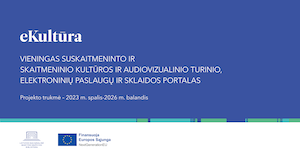The collection comprises the oldest documents kept in the Audio Collection of the Lithuanian Folklore Archives — recordings on phonograph cylinders (LTRF v) and phonograph disks (LTRF pl).
The first part of the collection is made up of 117 phonograph cylinders which were recorded between 1908–1949. Eduard Wolter was the first member of the Lithuanian Science Society to start recording Lithuanian folk music. Using Edison’s phonograph, he recorded Lithuanian folk songs, and melodies played on multi-pipe whistles skudučiai and bagpipes from 1908–1909 in the eastern and southern regions of Lithuania as well as in a Lithuanian enclave that is now in Belarussian territory — Zietala. Up until today 113 of his recorded cylinders survived, and a large part of them are kept in the Berlin Phonogram Archive, while only 14 original cylinders are kept in the Audio Collection of the Lithuanian Folklore Archives. From 1909–1912 Jonas Basanavičius also used a phonograph to record folk songs, and today we have 22 of his cylinders, which contain 40 songs. After Basanavičius died, this effort was carried on by Matas Untulis. He recorded folk songs from Lyda, Švenčionys, the Vilnius-Trakai region (20 cylinders with 118 recordings, most often only the first verses of the songs were recorded). During World War II and its aftermath, Zenonas Slaviūnas and Juozas Jurga recorded songs onto cylinders.
Most of the collection consists of phonograph disks with Lithuanian folk melodies recorded from 1935–1949. Today 980 of these disks have survived, containing over 6,700 pieces. The Commission for Gathering Folk Melodies that existed from 1934–1935 in Kaunas, the temporary capital of independent Lithuania, bought a stationary phonograph and began recording folklore onto the disks. This activity was continued by the Lithuanian Folklore Archive (1935–1939), which would invite folk singers and musicians from all regions of Lithuania to the temporary capital for recording (Z. Slaviūnas was the archive staff member in charge of recording). Thus the polyphonic songs Sutartinės, on the verge of disappearance in rural Lithuania, were documented on phonograph disks, along with traditions of polyphonic music-making with wooden trumpets ragai, and multi-pipe whistles skudučiai, as well as the voice of the patriarch of Lithuania Minor, Martynas Jankus, etc. Also recorded were calendar, work, youth, love, wedding, war-historical songs and songs of other genres as well as pieces performed on musical instruments: goathorn, flute (lamzdelis), reedpipe (birbynė), violin, Petersburg accordion, jaw-harp, dulcimer, and others.
In 2001, a program for the preservation and publication of archival sound recordings was launched at the Institute of Lithuanian Literature and Folklore. With support from Lithuania’s Ministry of Culture, the phonograph records were digitized (in charge of digitization was the LCVA specialist Vytautas Vizgintas), and a database for the registration of the digitized sound recordings was created (it can be found in Inventory documents). The best sound recordings representing the regional folklore of Suvalkija, Žemaitija, Aukštaitija and Dzūkija were selected, restored, and published over the course of 2003–2005 in a series of books with compact disks “1935–1941 Phonograph Recordings”. The phonograph cylinders were resurrected from oblivion in 2006 upon a visit from Vienna’s phonogram archive engineer and specialist of old sound recordings, Franz Lechleitner, to the Institute of Lithuanian Literature and Folklore. He digitized 105 cylinders (340 pieces) with a phonogram machine of his own making. In 2007 the highest quality recordings were selected and restored and their transcriptions were published in the book “The Phonograms of Lithuanian Ethnographic Music (1908–1942)”.
From 2006–2010, as part of projects funded by the State Science and Studies Foundation and the Lithuanian Science Council, a Folklore sound recordings database was created to house the metadata of these digitized recordings, which are integrated into the strategic Lithuanian Folklore Archives database as well.
|
Garso įrašas: |
|||||||
| Title: | Debesy, pro šalį | ||||||
| Žanras: | daina | ||||||
| Atlikimo pobūdis: | vokalinis | ||||||
| Laikmenos tipas: | fonografo plokštelė | ||||||
| Signature: | LTRF pl | ||||||
| Media number: | 521 | ||||||
| Unit number: | 1 | ||||||
| Trukmė: | 00:41 | ||||||
| Užrašymo data: | 1936 | ||||||
| Užrašymo vieta: | Kauno mst., Lietuvių tautosakos archyvas | ||||||
| Įrašo kokybė: | gera | ||||||
| Fondas: | LTR | ||||||
| Tekstų rinkinio nr: | 930 | ||||||
| Teksto eilės nr: | 51 | ||||||
| Melodijų rinkinio nr: | 2927 | ||||||
| Melodijos eilės nr: | 35 | ||||||
| Fotografijos archyvinis šifras: | LTRFt 267 | ||||||
| Pastabos: | Dainos tekstą 1936 metais iššifravo P. Mockaitis. | ||||||
| Pateikėjai: |
| ||||||
| Užrašytojai: |
1. Slaviūnas Zenonas | ||||||
| Melodijos šifruotojai: |
1. Uginčius Bronius () | ||||||





